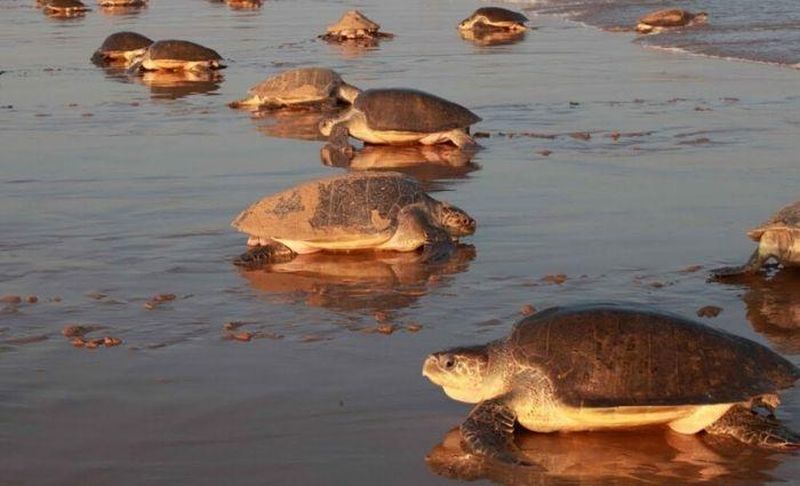With Humans in Lockdown, Olive Ridley Turtles Return for Nesting on Odisha Beach
The coronavirus outbreak has been chaotic and disruptive for mankind, but it has helped nature revive itself and reclaim back its space. People all across the world have reported sightings of wildlife around them.
According to the Forest Department, over 70,000 Olive Ridley arrived to take part in the unusual event of day-time mass nesting. Normally, throngs of people — tourists and locals— generally show up to watch the sea turtles and authorities have to deploy considerable resources to keep them away from the habitat.
A senior forest official has reported that around 250,000 Olive Ridley sea turtles have come ashore for mass nesting at the 6-kilometer-long Rushikulya beach in Ganjam district, Odisha, in the last few days.
ARRIBADA ~Spanish Word – means ‘Arrival’ ?
Refers to mass-nesting event when 1000s of Turtles come ashore at the same time to lay eggs on the same beach.
Interestingly, females return to the very same beach from where they first hatched, to lay their eggs.
?️ Olive Ridley Turtle pic.twitter.com/dvzslqA8zW— Ankit Kumar, IFS (@AnkitKumar_IFS) March 26, 2020
Known by the Spanish term arribada, this mass nesting started at the beach on March 20, 2020. The turtles came ashore in groups of 5,000-10,000 each.
Last year, the animals had skipped the beach, which was quite surprising for the turtle researchers. Their absence was earlier noticed in 2002, 2007, and 2017 as well. Meanwhile, around 300,000 turtles laid eggs in another rookery at Gahiramatha marine sanctuary in Kendrapara district recently.

Thousands of Olive Ridley Turtles on Odisha beach have laid eggs / Image: Scoop Whoop
The total number of turtles laying their eggs till now is over 7.9 lakh. While mass nesting at Gahirmatha is over, it is continuing at Rushikulya. It is estimated that around six crore eggs will be laid this year.
However, many turtles had laid eggs in pits dug by others and destroyed thousands of eggs in the process. Since the beach was littered with thousands of nesting turtles, many females have returned back to the sea and would be emerging after few days for laying eggs.
Thousands of olive ridley turtles nesting on the beaches of Odisha.
Their normal predators (humans) are in quarantine.
This season, their numbers will explode in the oceans.
There is a silver lining in this dark cloud after all. pic.twitter.com/l0DMLbGp4l— Dr. Ashley Jacob (@DrAshJac) March 26, 2020
Usually, the eggs take 45 days to hatch. Tiny hatchlings come out and make their way to the sea upon hatching.
Tourists have been barred from visiting the beach since the coronavirus lockdown has been implemented countrywide. But turtle researchers and environmentalists have been allowed to visit the nesting site.
Around 25 forest guards and turtle researchers are now patrolling the nesting beach and the sea to protect the turtles and their eggs. To ensure their survival, the team collects the eggs and bury them in many fenced hatcheries, where they incubate safely for about two months.
A turtle can lay on average 80 to 100 eggs each time. Every nesting season, the turtles are attacked by crows and jackals. Over time, Olive Ridleys can grow to be as big at 2 feet in size and weigh up to 50 kilos.
Via: India Times


